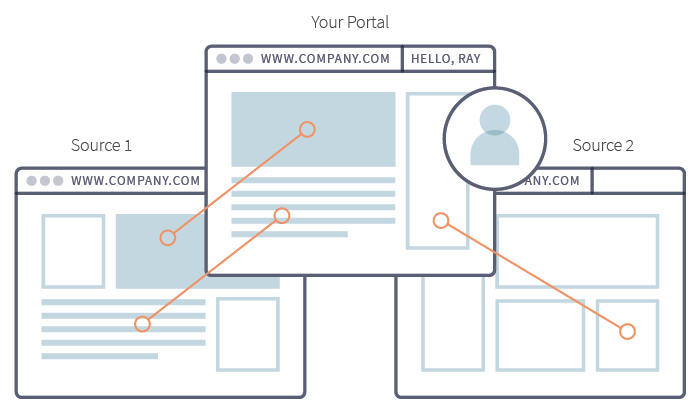Portal Platforms Are Designed for the Long Game
Most companies buy solutions based on what they need to complete their projects today, without considering what their tech stack will look like in a few years. This is why so many companies have problems with silos. If you make a habit of buying software on a project-by-project basis, in a few years you’ll have an unmanageable number of products being used throughout your organization.
This process can seem unavoidable, especially if you have a large organization with diverse teams that need to operate independently. Portal platforms are well-suited to solving this problem of siloed systems, as their primary strength is in consolidating a wide variety of tools.
For those in the middle of digital transformation, using a portal platform to house sites and applications can cut down on the amount of custom development work, because most of the necessary features are likely available out-of-the-box. Here are three major pain points that justify using a portal platform.
#1 You Have Too Many Systems
Portal platforms give you the ability to reverse the habit of buying too many systems in two ways. You can use portals to stitch together disparate systems or you can re-engineer these processes so they are baked into your platform. From there, your company is positioned to develop or integrate new tools as needed, without sacrificing the cohesiveness of your platform.
Additionally, a modular portal platform will make it easy to change one business process at a time, without running the risk of impacting your other existing processes. This is vital to most digital transformation initiatives and enables companies to control the pace of change within their organizations.

#2 You Have a Large Number of Diverse Audiences
Portal platforms are built for offering different content and services to different audiences. Many sites today use basic content targeting or context tools, but that often amounts to something as simple as swapping out an ad for men’s socks with an ad for women’s socks.
For companies that have truly diverse audiences (for example, a retail bank that targets college students, young homeowners and retirees), portal platforms can create a unique site for each segment, all within the same platform. Users see only what is relevant to them, and managing site content is easier for the administration team.
#3 Your Users Need to Be Able to Build Sites on Their Own
If you have users that need their own sub-sites that can be customized, but still stay within the control of the main site, then advanced site templating will make the job much easier. Portal platforms are equipped with templating for companies that need to create the same basic site over and over, before handing off the customization to the site owner, who adds her own content.
For example the GLOBE Program allows teachers all over the world to create classroom sites on globe.gov, which functions as an online teaching space for their students to learn about earth science. To make this possible, GLOBE uses key portal platform features to create site templates, so every classroom site has the same core functionalities for students. This makes the data they collect easier for GLOBE to manage, and it gives teachers less work to do in maintaining their individual sites.

Build for the Future, Not for Today
Portal platforms are a lot like toolkits, especially now that so many include adjacent technologies out-of-the-box. When companies have the opportunity to move a complicated manual process to a streamlined digital solution, they should also consider moving to a portal platform that can automate standardized tasks and free up employee time to innovate.
Some digital leaders are even addressing this by building innovation into their IT strategy. Rather than gathering point solutions, they focus on building a framework that standardizes as much as possible for any future application or website they need to build. This strategy allows developers to focus on engineering only the components that provide true business value, rather than always recreating the same basic foundation. Strategies like this are the backbone of many digital initiatives, and having a reliable platform that is capable of supporting it is key.
Learn About Four Portals That Solve Enterprise Problems
Get the E-BookScopri come creare una soluzione adatta alle tue esigenze
Via Torri Bianche 9 - Torre Quercia
20871 Vimercate (MB)
Tel: +39 0399002080